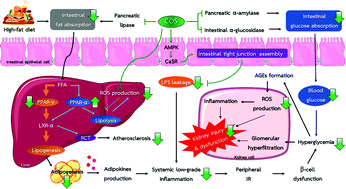The potential roles of chitosan oligosaccharide in prevention of kidney injury in obese and diabetic conditions
Abstract
Obesity is closely associated with insulin resistance (IR). The most likely links between the two are obesity-mediated systemic low-grade chronic inflammation, endoplasmic reticulum stress and mitochondrial dysfunction, which are all known to contribute to the development of type 2 diabetes (T2DM) and eventually diabetic nephropathy (DN). Chitosan oligosaccharide (COS) is an oligomer of chitosan prepared by the deacetylation of chitin commonly found in exoskeletons of crustaceans such as shrimp and crab as well as the cell walls of fungi. COS has various biological effects including lipid lowering, anti-inflammation, anti-diabetes, and anti-oxidant effects. Therefore, COS is a potential new therapeutic agent for treatment of the obesity-induced DN condition. It is an abundant natural polymer and therefore freely available. This review includes information regarding the relationship between obesity, IR, T2DM, and DN as well as the potential usefulness of COS in controlling lipid and cholesterol metabolism, T2DM and kidney injury models in both in vivo and in vitro studies. However, evidence is limited regarding the effect of COS on the DN model. Further studies, especially in obesity-induced DN, are needed to support the mechanisms proposed in this review.

- This article is part of the themed collection: Recent Review Articles


 Please wait while we load your content...
Please wait while we load your content...